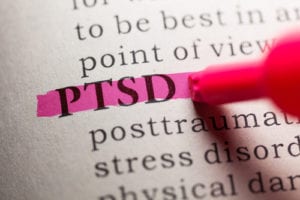70% of adults will experience a traumatic event in their life- over 220 million people. Of those 220 million, PTSDunited.org reports, 20% of them will develop PTSD as a result. PTSD, post-traumatic stress disorder, affects 8% of Americans at any given time, according to the website. That percentage of people, they compare, is equal to the population of Texas.
Post-traumatic stress disorder is a rare development in response to trauma. Mistakenly, people assume that trauma is followed by the development of PTSD. While people can have aggravated emotional responses to trauma that may look similar to PTSD, it isn’t PTSD itself.
Symptoms of PTSD include
- Vivid memory recall and flashbacks of a traumatic event which can feel unwanted and out of control
- Nightmares, night terrors, about the event
- Experiencing emotional numbness or an inability to connect to one’s emotions
- Constant state of panic, paranoia, or anxiety
- Anger or rage; can be accompanied by violent outbursts
- Reports of feeling constantly “on edge”
- Becoming withdrawn socially or avoiding relationships due to fear of being reminded; impairing quality of life to avoid potential triggers
- Easily set off by triggers of the event; for example, someone who has combat trauma might be triggered by a gunshot or a sound that resembles a gunshot.
How Trauma Works In The Brain
Trauma impacts the brain in three regions, all of which have different contributions to the symptoms of PTSD. First is the hippocampus. Primarily, the hippocampus is responsible for creating and storing memories. In a brain suffering from PTSD, the hippocampus actually loses its storage capacity for new memories and keeping old memories. Second, is the amygdala. The amygdala is like the air traffic control for fear in the brain, deciding what responses need to go where and how intensely. When PTSD occurs, the amygdala loses all of its control, leaving chaotic traffic. Last is the medial prefrontal cortex. While the amygdala regulates fear, the medial prefrontal cortex gets rid of fear. For example, the amygdala might decide it is very afraid of heights. However, after a few safe exposures, the medial prefrontal cortex can decide heights aren’t so scary. With PTSD, the medial prefrontal cortex loses its ability to extinguish fears, enhancing the chaos left behind by the malfunctioning amygdala.
Repairing Trauma
Through evidence-based therapeutic methods, the symptoms of PTSD can be significantly lessened. Treatment methods such as EMDR, eye movement desensitization and reprocessing, help the brain return to an even state so it can go about its proper functioning. Other therapeutic methods include cognitive behavioral therapy and contextual therapy.
Avalon By The Sea proudly provides one of California’s few licensed mental health facilities, able to treat psychiatric issues as a primary diagnosis. Avalon is dedicated to providing a safe, relaxing environment for mental health treatment. Settled along the coastline of iconic Malibu, California, Avalon offers the privacy and luxury needed to effectively treat mental health issues. For a confidential and professional assessment and more information about our programs for mental health treatment, call 1-855-464-8492.











